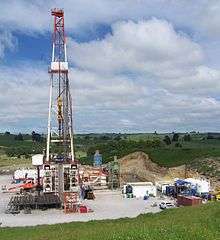Renewable energy in New Zealand
Approximately 40% of primary energy is from renewable energy sources in New Zealand.[1] Approximately 80% of electricity comes from renewable energy,[1] primarily hydropower and geothermal power.
| Part of a series on |
| Renewable energy |
|---|
|

Renewable energy by type
Renewable electricity
Renewable electricity in New Zealand is primarily from hydropower. In 2017, 82% of the electricity generated in New Zealand came from renewable sources.[1] In September 2007, former Prime Minister Helen Clark announced a national target of 90 percent renewable electricity by 2025, with wind energy to make up much of that increase.[2]
Solar power
Solar technologies in New Zealand only became affordable alternatives in the mid-2010s, compared to previous renewable offerings. The uptake in the residential and commercial market, though slow, has increased steadily. As with all renewable options, price of generation is key to the sustainability. It is only these recent changes in pricing that may see solar generation plants in the future.
Solar hot water
Installation of solar hot water heating systems is increasing in New Zealand due in part to government incentive schemes.
Bioenergy
According to the New Zealand Bioenergy Association, more than 10 percent of New Zealand's energy currently comes from bioenergy.[3]Biodiesel, bioethanol and biomass (generally in the form of wood) are all used in New Zealand as a source of renewable energy.
Biomass
New Zealand is rich in biomass from wood and waste which can be used as fuel. Biomass is sourced primarily from in-forest and wood processing residues and municipal wood waste. This can be processed into pellets, chip or hog fuel.[4]
Wood fuels are sustainable and carbon-neutral[5] and can provide New Zealand with a greener economy, less dependent on fossil fuels.[6]
New Zealand Ministry of Business, Innovation and Employment data [7] shows wood fuel is the cleanest energy consumed for industrial process heat by a large margin.[8]
The Bioenergy Association of New Zealand has investigated the potential for greenhouse gas reduction brought about by switching from fossil fuel to wood biomass for industrial heat.[9] It assessed that by 2050 New Zealand could more than double 2017 biomass energy supply, providing up to 27% of NZ's energy needs and realising a 15% reduction in greenhouse gas emissions.[9]
Milk processing provides current examples of biomass use in industry:
Biomass is also used for heating in hospitals, schools and universities.[12]
Wood fuel industry leader, Azwood Energy, advocates for government policy change to incentivise and accelerate fuel switching to biomass, in order to improve emissions reduction.[13][14][15] Dr Martin Atkins, Senior Research Fellow with Waikato University's Energy Research Group, believes using woody biomass as a fuel source for industrial processes will be vital in meeting New Zealand's GHG emissions reduction targets.[16]
See also
- Energy in New Zealand
- Renewable energy commercialisation
- Solar power in New Zealand
- Wind power in New Zealand
- Ocean power in New Zealand
- Geothermal power in New Zealand
- Biofuel in New Zealand
- Hydroelectric power in New Zealand
- Solar hot water in New Zealand
- Renewable energy by country
References
- "Energy in New Zealand 2017". MBIE. October 2017.
- Clark, Helen (20 September 2007). "Launch of emissions trading scheme". New Zealand Government. Retrieved 19 January 2010.
- "Bioenergy – the renewable fuel | Bioenergy Association of New Zealand". www.bioenergy.org.nz. Retrieved 15 September 2019.
- "Information Sheet 43: Biomass fuel resource availability projections | Bioenergy Association of New Zealand". www.bioenergy.org.nz. Retrieved 15 September 2019.
- "Business Scoop » Why Forestry Biomass Is Carbon Neutral". Retrieved 15 September 2019.
- "The Wood Fuels Market" (PDF). Bioenergy Association of New Zealand. January 2018. Retrieved 16 September 2019.
- "Process Heat – Overview". Ministry of Business, Innovation & Employment. November 2018. Retrieved 16 September 2019.
- Wednesday; November 2018, 14; Energy, 2:16 pm Press Release: Azwood. "MBIE's GHG Figures Define Clean Energy | Scoop News". www.scoop.co.nz. Retrieved 15 September 2019.CS1 maint: numeric names: authors list (link)
- https://www.bioenergy.org.nz/documents/resource/Information-Sheets/IS32-GHG-reduction-using-wood-energy.pdf
- "Fonterra's Brightwater site burns wood biomass to reduce emissions". Stuff. Retrieved 15 September 2019.
- "Danone to cut carbon emissions at Balclutha plant to zero". Stuff. Retrieved 15 September 2019.
- McPhee, Elena (22 June 2019). "Woodchips cleaning up Uni heating". Otago Daily Times Online News. Retrieved 15 September 2019.
- Evans, Gavin (20 November 2018). "Policy needed to boost NZ's wood fuel use". ISSN 1170-0777. Retrieved 15 September 2019.
- "Business Scoop » Woody Biomass – the Obvious Solution". Retrieved 15 September 2019.
- Wednesday; December 2018, 5; Energy, 4:06 pm Press Release: Azwood. "Renewable Energy Supply Constraints | Scoop News". www.scoop.co.nz. Retrieved 15 September 2019.CS1 maint: numeric names: authors list (link)
- Friday; October 2018, 26; Energy, 1:15 pm Press Release: Azwood. "Renewable Energy Futures: Biomass & Electricity | Scoop News". www.scoop.co.nz. Retrieved 15 September 2019.CS1 maint: numeric names: authors list (link)
External links
| Wikimedia Commons has media related to Renewable energy in New Zealand. |